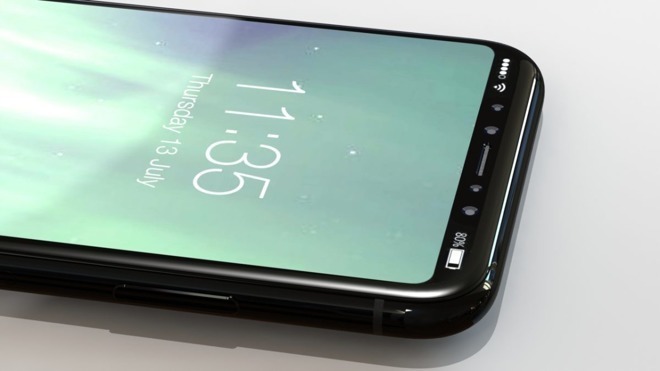Digging deeper into HomePod firmware that was released over the weekend, developer Steven Troughton-Smith is coming up with additional details surrounding Apple's next-generation iPhone, including what could be confirmation of a split status bar user interface and a new "tap to wake" feature.

Image credit: Nodus and Gordon Kelly
Troughton-Smith in a tweet on Monday notes code points he uncovered identify a new visual provider system for the UIStatusBar, including a "split" option that would presumably divide status information like cellular connectivity, battery capacity, Wi-Fi strength and more into two sections.
The information dovetails with previous leaks that suggest "iPhone 8" will sport a large central cutout at the top of the display to make space for an earpiece, front-facing FaceTime camera and specialized sensors that enable 3D sensing. An image thought to show a silhouette of the next-gen device, pulled from the same HomePod firmware, seems to confirm a split status bar design.
Troughton-Smith adds that the status bar "seems a lot more complex and powerful in design, maybe even interactive," but fails to elaborate on potential functionality.
In a separate tweet, the developer notes a distinct lack of new assets that would betray the inclusion of an embedded Touch ID module.
"For what it's worth I've seen nothing to suggest an ultrasound under-the-display Touch ID here. Looks like not this year. Quash that one," Troughton-Smith said.
An embedded fingerprint reader is one of "iPhone 8's" more eagerly -- and frequently -- cited rumors, but exactly how Apple intends to implement the technology remains unclear. Aside from ultrasound tech, the company could feasibly apply an advanced under-glass optical sensing solution similar to current Touch ID iterations.
Still, as Troughton-Smith points out, the firmware would require new UI assets for directing user interactions. The developer has yet to find evidence of such code, casting doubt on an embedded solution arriving this fall.
Whether the device will incorporate under-glass Touch ID is up for debate, but a full-screen display sans home button seems to be confirmed. Instead of a physical part, code suggests Apple is likely to employ a virtual home button called the "home indicator" that can be hidden depending on the situation. Related to home button graphics is a new "dock" UI Troughton-Smith discovered in code for the soft keyboard. He believes the new UI could signal a shift of certain buttons like the international keyboard and emoji (globe icon) and voice input (microphone icon) buttons to the new home button area.
Elsewhere in the HomePod code are hints at ARKit and Photos integration with the rumored 3D-sensing FaceTime camera. Developer Guilherme Rambo found strings related to the detection of facial expressions and features like smiles, frowns, puckers and dimples.
Also discovered was reference to "tap to wake," which could be similar in function to a feature introduced with Microsoft Lumia devices running Windows Phone. Those smartphones allowed users to wake their device with a quick double tap on the screen.
Apple is expected to debut "iPhone 8" in September alongside incremental improvements to the iPhone 7 series. The new flagship is rumored to come jam packed with new features and functionality including the aforementioned 3D-sensing FaceTime camera, full-face OLED display, wireless charging and AR capabilities.


